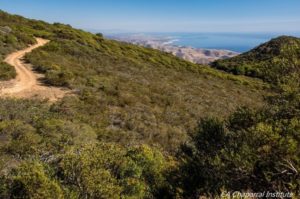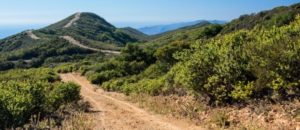
All vegetation within 150 ft on each side of this road will be cleared for 6 miles between Gaviota Peak and Santa Ynez Peak. Courtesy the California Chaparral Institute
Yesterday ForestWatch and the California Chaparral Institute filed a lawsuit in U.S. District Court to protect the Refugio manzanita, a rare plant that grows in the path of a massive fuel break that was recently approved in a remote corner of the Los Padres National Forest. The suit is also an effort to encourage forest officials to focus on reducing fire risk where it matters most, directly in and around communities.
The Gaviota Fuel Break would clear-cut native chaparral habitat across a six-mile-long, 300-foot-wide swath between Refugio Pass and Gaviota Peak, along the crest of the Santa Ynez Mountains. The site – located far away from any structures – lies at the heart of the Gaviota Coast, one of the crown jewels of Santa Barbara County.
Ironically, the Forest Service’s experts consistently state that the best way to protect communities from wildfire is to create defensible space immediately around structures, and to construct and retrofit homes with fire-safe materials. Remote fuel breaks, such as the Gaviota Fuel Break, are considered to be costly and often ineffective at stopping fires.

The Refugio manzanita is incredibly rare, only growing in a handful of locations at higher elevation in Santa Barbara County.
In rushing to approve this project, the Forest Service failed to take simple steps to protect one of the rarest manzanita species on Earth. The Refugio manzanita is considered “endangered” by the California Native Plant Society and only grows in a narrow band between Point Conception and Santa Ynez Peak along the south coast of Santa Barbara County. The Refugio manzanita is too important to sacrifice for an ineffective, expensive fuel break that is far-removed from communities.
Our lawsuit alleges that the fuel break violates the National Environmental Policy Act and the National Forest Management Act, two of our nation’s bedrock environmental protection laws. The Forest Service approved the project without preparing an Environmental Assessment, and without proposing any measures to protect manzanitas and other rare plants and animals in the area.

Refugio manzanita can be seen growing along the road that will be in the center of the clear-cutting project. Courtesy the California Chaparral Institute
Officials exempted the project from environmental review by miscategorizing it as “timber stand improvement” even though there is no timber in the area. This miscategorization eliminated the ability of conservation groups and scientific experts to formally object to the project and work with the Forest Service to address these concerns before the project was approved.
Our lawsuit asks the court to order the Forest Service to do the required analysis of the impacts of the Gaviota Fuel Break and to act consistently with the Los Padres Forest Plan by avoiding or reducing any potential harm to Refugio manzanita and other rare plants and animals that may be affected by the fuel break. We are represented by Earthrise Law Center, the environmental law clinic at Lewis & Clark Law School in Portland, OR – one of the top environmental law programs in the country.







Comments are closed.